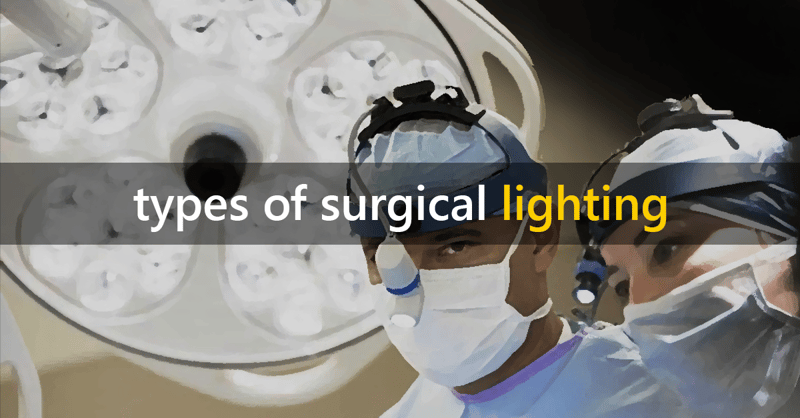
While the quality of light is vital for the success of an operation, the type of surgical lighting that is used varies depending on the needs of the surgeon. Surgical lighting should provide bright, homogeneous, and focused light to enable surgeons to accurately visualize anatomy at the surgical site. Modern surgical lighting can be split into three categories: overhead lighting, head lighting, and in-cavity lights. Each type has pros and cons when it comes to their usefulness to the surgeon and surgical team.
Overhead Lights
Overhead lights are the most recognized surgical lights. These lights are LED, halogen, or high intensity discharge (HID) and are generally mounted on a ceiling or wall. They are adjustable in any axis of movement to create the best view for the surgeon and to prevent glare and shadows in the surgical site. Surgeons manipulate the lights by grabbing the removable handles that can be sterilized after a procedure. The typical OR has a constellation of multiple overhead lights to optimize illumination of the surgical site.
The overhead lights are perfect for lighting the general field and for relatively shallow open surgeries however it does not offer the directed light needed for deep cavities and detailed illumination and is still subject to shadowing due to objects between the light and the field. In addition, they can create a diffused light pattern which can affect the surgeon’s view of the surgical site. Another issue is that the lights are heavy and during manipulation can inadvertently bump into a surgical team members head.
Headlights
Headlights are worn by the surgeon to provide light directly in line with their vision. They are often used in conjunction with loupes and deliver a small area of intense illumination usually 1-5” in diameter on the target surface.
Older headlight system that use a fiber optic cable tethered to a separate light generator are slowly being replaced by battery operated LED systems. The newer headlights enable surgeons to have more mobility and are lighter weight than the older hardware.
A fundamental drawback of the headlight is the need for the surgeon to keep their head aimed at the spot they are focused on. This can be for a short time or for very long periods of time. If your head moves your light moves and reacquiring the target of the light results in a break in the surgeon’s concentration and workflow. As lightweight as the new headlights are they are still worn on the surgeon’s head which can cause discomfort at the least and genuine pain if the headband is too tight or ill-fitting. Furthermore, headlights are not sterile, meaning the surgeon cannot touch their headlight to adjust it and must seek assistance from other team members.
In-Cavity Lights
Not all operations are in areas of the body that are easy to illuminate with overhead lights or even headlights. That’s when in-cavity lights can be useful to help give more light to these hard-to-reach areas. This type of light is usually attached to a surgical instrument or embedded in a retractor system.
However, this type of lighting isn’t always practical or effective. In-cavity lighting is not very bright and therefore may not properly illuminate the area in question. Lighted retractors are good for some deep cavity situations but can also get in the way. Surgeons are very particular about their retractors and proper retractor setup is a fundamental element of performing surgery so adding lights to retractors is not acceptable for many.
In Summary
Effective lighting in the OR is one of the most critical factors in the surgical environment. Without the correct type of lighting the risk of surgical errors increases, not because of the surgeon’s skill or knowledge but simply because they may not be able to see what they need to see.
MezLight gives the surgeon a bright, directable, focused light that is sterile and easy to use. The flexible neck is designed so you can bring it into the field when needed and quickly move it out again when it is not. It can be repositioned continuously throughout a procedure and holds its position as you left it, giving you handsfree focused illumination where and when you need it.


